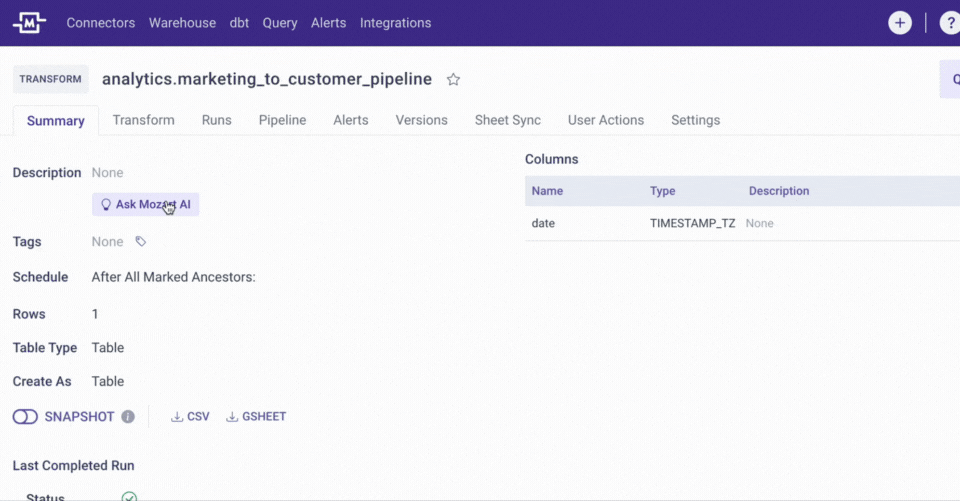Introducing Mozart AI
To enable our customers to fully take advantage of the power of AI in their data workflows, we are incorporating OpenAI's GPT model into Mozart Data. This document outlines how to use Mozart AI in various parts of our product. Read more about it on our our product launch announcement blog post!
Getting Started
In order to use the Mozart AI features, an Admin user must first allow AI to be used at the company settings. Here's how:
- Go to the Settings page.
- Click on the Company tab.
- Toggle 'Allow AI' on.
Using Mozart AI
Currently, we have a suite of four AI-powered features available in the Mozart Data platform:
1) AI Assistant
The AI Assistant is an interactive tool to write valuable SQL queries for data analysis or modeling (data transformation). By indexing all metadata from your data warehouse's existing tables and views, AI Assistant generates precise SQL outputs tailored to your requirements. Simply ask a question and get instant answers.

How to use this feature:
- Navigate to the Query page or a Transform table page.
- Ask a question in simple, plain English to write a new query or improve an existing query from the query editor. For best results, make sure to include table and column names, and provide as much context as possible.
- Copy & paste into the query editor and run the query.
Use-case examples
- Data Analysis: Please analyze the monthly marketing spends on Facebook Ads and Google Ads and report on the ROI (e.g. clicks, visits)
- Data Modeling: Build a SQL query that returns row-level information about each user and their product usage trends and demographic information from [insert table name(s)]
- Edit SQL Query: Add date_of_birth and is_active as new columns to the query. A user is considered active if they last signed in within the past 7 days
- Optimize SQL Query: Make edits to the query to optimize the run-time while returning the same results
2) Fix SQL
If you're struggling to understand why your query isn't functioning properly, Mozart AI eliminates the need for guesswork.

How to use this feature:
1. When your SQL query returns an error, click the 'Fix SQL' button a button. Mozart AI will provide instant fixes to your SQL errors.
2. Click on the 'Apply Fix' to replace the incorrect query with the correct code.
3) AI Table Description
As our initial AI project, we launched AI-Generated Table Descriptions. This feature generates useful description about the tables based on important metadata, such as the query itself as well as information about the upstream and downstream tables.

How to use this feature:
- Go to the 'Summary' tab within the table page and click on the 'Ask Mozart AI' button, which will initiate the AI generation process.
- If you are not satisfied with the AI-generated table description, you can click on 'Regenerate' to generate a new one.
- Once Mozart AI provides a satisfactory description, you have the option to either 'Append' it to the existing description or 'Replace' the existing description with the AI-generated description.
- Please click on one of the three face icons (Yes, Somewhat, No) to let us know if the AI-generated description was helpful. We highly appreciate your feedback.
4. Explain SQL
The "Explain SQL" feature analyzes your SQL queries and creates clear, easy-to-understand summaries. Its goal is to enhance communication between technical and non-technical team members by providing accessible summaries. This allows all data users in the company to quickly grasp the purpose and actions of any SQL query without requiring deep technical knowledge or background context. By using Explain SQL, you can save time by avoiding the need for manual explanations to your stakeholders or team members.

How to use this feature:
- Go to an existing SQL query in the Query page or on a Transform table page.
- Click on the 'Explain SQL' button.
Disclaimers
- Please note that Mozart Data does not send the content of your data to OpenAI. We only send and use metadata such as the SQL text, table/column names, existing table/column descriptions, and data types.
- Open AI may record any information you provide or questions you ask. We advise against including sensitive information such as personally identifiable information (PII) or company secrets in your SQL queries or existing documentation if you prefer not to share them with Open AI. You can simply delete them from your metadata or not use the AI features for those tables.
- Please double-check any results generated by AI in order to ensure accuracy.
PS. Yes, this page was drafted with the help of AI :)
.png?height=120&name=Mozart%20Data%20Logo%20-%20Purple%20(2).png)
